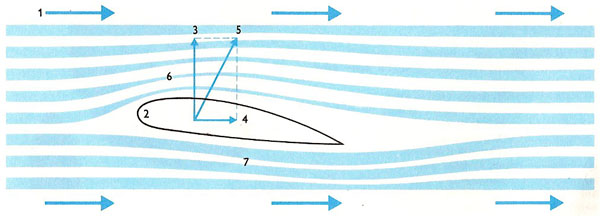airfoil

Airfoil. The arrows (1) show the relative motion of the air through which the airfoil (2) is moving. Air travels past the upper edge faster than past the lower edge, so that there is a region of low pressure (6) above the airfoil and one of high pressure (7) below. This results in the airfoil experiencing vertical life (3) at right angles to the drag force (4). The resultant of the lift and the drag forces is the aerodynamic force (5).

An airfoil is a structure shaped so as to produce an aerodynamic
reaction – lift– at right-angles
to its direction of motion. Familiar examples include the wings of an airplane or the Space Shuttle. Elevators, ailerons, tail-planes,
and rudders are also airfoils.
An airfoil has a leading edge, a trailing edge, a chord,
and acamber. The leading edge is the "front" of the airfoil – the portion that meets the air first.
The trailing edge is the back of the airfoil – the
place at which the airflow over the upper surface of the airfoil joins the
airflow over the lower surface of the airfoil. The chord of an airfoil is
the imaginary straight line drawn through the airfoil from its leading edge
to its trailing edge.
The direction of the air that is flowing past an airfoil relative to the path of flight is called the relative wind. The relative wind is always parallel and opposite in direction to the path of flight.


